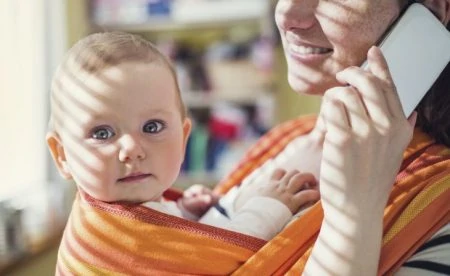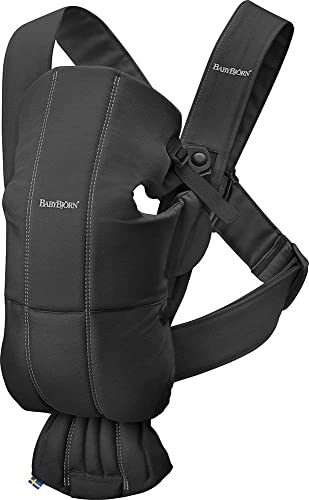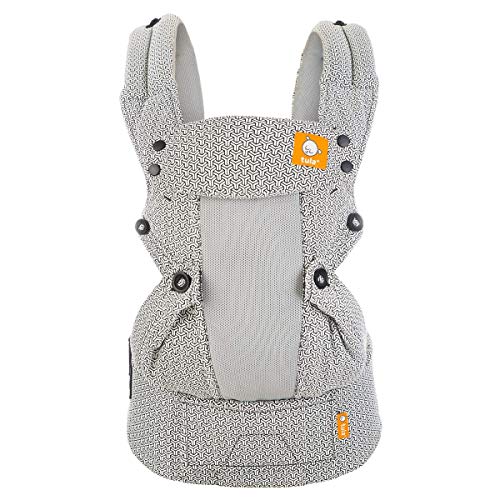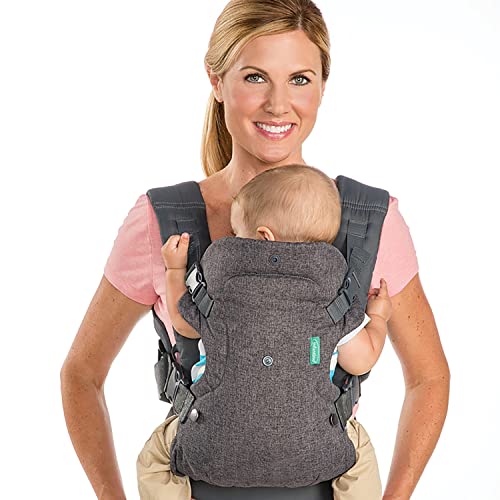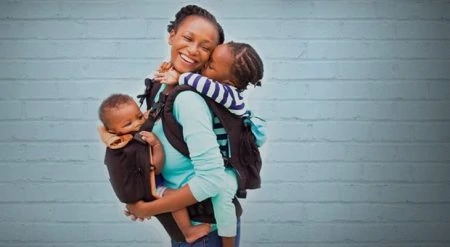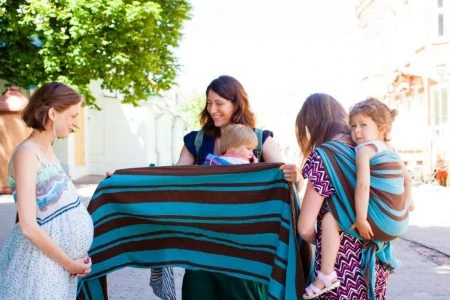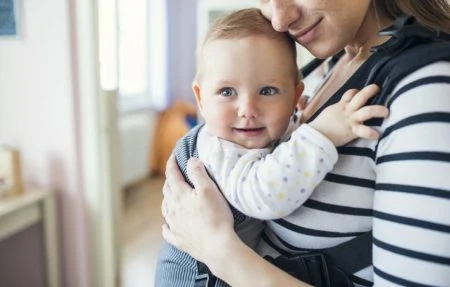You already know that a baby carrier will be a life-changer, freeing your hands and helping you bond with your baby. But with thousands of carrier options available, making your first purchase can be overwhelming.
We have years of experience using baby carriers of all types, and we’ll explain the differences to you, helping you choose the style that will meet your individual needs.
We’ll also provide a list of all the best baby carriers for every situation, so you won’t waste your time and hard-earned money on products that don’t measure up.

- Fully machine washable
- Comes with a storage bag
- Ergonomic seat

- Non-toxic
- Hand woven slings
- Good-looking, stylish alternative

- Gender-netural design
- Small and compact
- Trustworthy brand

- Six positions & 360° carrying
- Adjustable layers
- Machine washable

- Worn at different heights
- Supports ergonomic carry position
- Can support up to 45 pounds

- Extremely versatile
- Comes with lumbar support
- Includes a detachable pouch

- Padded, adjustable neck pillow
- 100% cotton
- Allows for multiple carry positions

- Affordable
- Perfect for all outfits
- Ergonomically correct seat

- Great breathability
- Kind on sensitive skin
- Includes storage bag

- Easy-to-adjust straps
- Grows with your baby
- Lightweight, simple design
Best Baby Carrier Reviews of 2023
Here are our favorite baby carriers currently on the market.
MiaMily Hipster Plus Baby Carrier
Best Baby Carrier for Hiking
Whether you like carrying your baby against your chest or your back, this carrier by MiaMily has you covered. You can carry your baby in every conceivable way with this pack that includes a detachable hip seat.
Your baby should be completely safe in this backpack with its top-of-the-line safety features like a full-waist belt that provides lumbar support and cushioned shoulder straps. The system can fully adjust from either the front or back so you’ll always be able to reach what you need when you want to tweak the fit.
The Hipster Plus carrier can hold your newborn baby with a minimum weight of eight pounds until they are 44 pounds or four years old. It also comes with a hood to ensure full protection from the sun.
Pros
- Fully machine washable.
- It comes with a useful storage bag.
- Ergonomic 6-position seat.
Cons
- In the higher cost range.
Our Ratings
Hip Baby Wrap Ring Sling
Best Ring Sling
If you’re looking for a fun sling-style baby carrier with some color and pizzaz, check out the Hip Baby Wrap ring sling. Its bright colors and patterns will stand out from the crowd.
You can use this sling to carry your baby on either hip, in a cradle carry, tummy-to-tummy, or even on your back. It fits children who weigh 8 to 35 pounds.
Made of 100 percent cotton, it’s breathable and soft so both you and your baby will feel comfortable. The aluminum rings are durable and strong.
The simple design takes the strain off the shoulders and neck, so you can comfortably nurse your baby in the carrier or use it as a cover for nursing in public.
This low-maintenance sling is machine washable — a great feature for busy moms.
Pros
- Made with safe, non-toxic dyes.
- Fair trade fabric handwoven in India and colored with plant-based dyes.
- A stylish alternative to solid-colored slings.
Cons
- No padding in the shoulder area.
Our Ratings
BabyBjorn Mini Baby Carrier
Best Baby Bjorn Carrier
This soft structured carrier by Baby Bjorn will allow you to snuggle your baby as you go. You can face your baby toward your chest or outward, and it doesn’t require a special infant insert for newborn use.
Pediatricians helped design this carrier to be everything a baby needs, supporting their spine, hips, head, and neck. The head support is firm and adjustable, so as your baby’s neck muscles get stronger, you can adjust the support.
Because your baby’s legs and arms can move freely in this carrier, their development won’t be hindered while they enjoy extra time in their caregiver’s arms.
You won’t have to spend a lot of your time figuring out how to use this, either. You can strap it on and have it adjusted in no time.
Pros
- Trustworthy brand has been making baby products since 1961.
- Small and compact compared to some other options.
- The upright carry helps keep baby’s airways open.
Cons
- Lack of back support.
- The straps have the tendency to pull on the shoulders and neck.
Our Ratings
LilleBaby Baby & Child Carrier
Best Baby Carrier for All Seasons
This LILLEbaby six-position carrier is versatile and supportive for both mom and baby, allowing for 360-degree carrying. From long outings in the great outdoors to at-home babywearing, you can find a position that will help you both feel comfortable.
The carrier has an exclusive temperature-regulation panel, so you can venture out in all sorts of weather. When it’s cold, zip it up to keep your little one toasty, especially in the front-facing position. For hot weather, zip it down to reveal a cool, breathable mesh that allows air to circulate around your baby.
Other features include a padded waist belt for extra lumbar support, customized straps to fit all body types, and machine washable materials.
If your family loves the outdoors, this baby carrier will help your baby join you as you adventure together.
Pros
- Six position, 360-degree carrying.
- Adjustable layers help keep baby’s temperature regulated no matter the weather.
- Machine washable.
Cons
- Inner fabric is not very soft for babies.
Our Ratings
Ergobaby Omni 360 Ergonomic Baby Carrier
Best Baby Carrier for C-Sections
Ergobaby’s all-in-one carrier provides exceptional comfort for both you and your baby. You can use it in a number of different ways to suit your needs, and the adjustable bucket seat supports your baby in an ergonomic natural “M” position.
If you’ve had a Cesarean section, you’ll especially appreciate the waist belt. It can be worn low or high to maximize comfort and ensure the pressure isn’t placed on the sensitive area of your belly.
Though every mom is different, we suggest you wear the waist belt higher when you’ve had a C-section. The weight of your little one will naturally cause the carrier to sink and may drop as your baby wriggles around. Starting higher will prevent unnecessary pain as you test it out for the first time.
The Ergo 360 is made of machine-washable fabrics and includes a UPF 50+ tuck-away baby hood for sun and wind protection.
Pros
- An adjustable waistbelt prevents pressure on C-section sutures.
- Supportive ergonomic position is safe for baby’s hip development.
- Includes a baby hood for added sun protection.
Cons
- Inner mesh fabric isn’t very comfortable for babies, especially in hot weather.
Our Ratings
Bebamour Adjustable Mesh Baby Carrier
Best Forward Facing Baby Carrier
The Bebamour mesh is a great option for moms looking for a forward-facing baby holder. The best part about this baby carrier is that you can use it in other ways too. You can cuddle your baby while they’re facing inward, or you can use the carrier as a baby backpack.
The ventilated mesh makes this an excellent option to keep your baby from getting overheated in hot weather. The thick waistband provides lumbar support, which you especially need when your baby is facing forward.
This carrier has an easy learning curve, and with its padded straps, it’s comfortable to wear. The dark grey color makes for a gender-neutral carrier.
Pros
- Extremely versatileIncludes a detachable pouch.
- Wide waistband offers extra lumbar support.
- Includes a detachable pouch.
Cons
- You can’t breastfeed your baby while using this.
- The material is a little scratchy and might irritate your baby’s sensitive skin.
Our Ratings
Baby Tula Sleepy Mesh Carrier
Best Baby Carrier for Sleeping
We love the comfort level provided by the Baby Tula carrier. It can be used at any time, but there are a few features that make it especially good for when your little one is sleepy.
It’s made of 100 percent cotton and is super soft and breathable. Your baby will love feeling it on their skin. Moms will love it too because they can throw it in the washing machine for easy laundering.
It also has extra padding for both mom and baby. The padded shoulder straps and waistband help distribute your child’s weight so you can carry them for longer periods while also allowing for quick adjustments without disturbing your sleeping baby.
One of our favorite features, however, is the padded, adjustable neck support pillow. Use it in multiple positions to provide head and neck support for your baby as they sleep.
Pros
- Padded, adjustable neck pillow provides ultimate baby comfort.
- Made of soft 100 percent cotton that is machine washable.
- Allows for multiple carry positions to suit your baby’s needs.
Cons
- Wide straps hide smaller babies’ faces.
- Steeper learning curve.
Our Ratings
Infantino Cuddle Up Ergonomic Carrier
Best Ergonomic Baby Carrier
The Infantino Cuddle Up is designed to position your child’s legs in the desirable frog-like position that will help their hips continue developing correctly. You can wear it as a backpack or on your front.
It has a cute canopy hood that looks like a teddy bear, so whether it’s cold or your baby needs some shade from the sun, they’ll be protected while looking adorable. If you think you won’t need the hood when you’re out and about one day, you can remove it so it doesn’t flop around when you’re walking.
This can hold kids that weigh from 12 to 40 pounds, and it can be machine washed so you can keep it looking fresh between uses.
The wide waist belt helps take some of the strain off your back, which means you’ll be able to carry your baby longer without feeling discomfort.
Pros
- One of the cheapest soft structured carriers.
- The basic gray color shouldn’t clash with any of your outfits.
- The ergonomic seat is comfortable for babies.
Cons
- It won’t work for breastfeeding.
- May require an extra set of hands to adjust the fit securely.
Our Ratings
Acrabros Baby Wrap Carrier
Best Breathable Carrier
No matter the season, the Acrabros baby wrap carrier is a top choice. In the summer months, enjoy the cool, breathable properties of the wrap. During the winter, you’ll notice that your baby remains warm and cozy wrapped up in this sling.
This is a comfortable and practical way to keep your baby close and safe as you do chores and errands. Keep them facing you as you’re grocery shopping, working at the computer, or sorting the laundry.
This carrier is suited for babies from 8 to 35 pounds, so you can use it from when they’re very young until they’re well into toddlerhood if they still fit.
The carrier comes in four gender-neutral designs to suit any wearer and has double-sided stitching for ultimate durability and strength, even for heavier babies.
Pros
- Breathable fabric.
- Fits 8 to 35-pound babies.
- Gentle on sensitive skin.
- Included storage bag.
Cons
- Material is very stretchy, so it’s quite hard to work with.
- Lots of extra material, especially for shorter women.
Our Ratings
Infantino Flip 4-in-1 Convertible Carrier
Best Baby Carrier for Dads
Families on a budget will love this affordable carrier! It grows with your baby and can be used by anyone.
With a lightweight design and four carrying positions, the Infantino Flip carrier is perfect for everyday use by mom or dad. There are two front-facing positions available, one with a narrow seat and one with a wide seat. As your baby grows, they can face outward or be carried on your back.
Because the seat is adjustable to fit perfectly, you don’t have to worry about purchasing an extra infant insert or another carrier as your baby gets older. With this carrier, you can wear your child until they’re approximately 32 pounds.
We love this baby carrier for its easy-to-adjust straps that fit people of all sizes. You can pull them to the perfect position so they fit comfortably. Better yet, all the straps are padded, and there’s even a waist belt for extra back support.
Pros
- Easy-to-adjust straps can fit any body shape and size.
- Easily adjustable as baby grows.
- Lightweight, simple design.
Cons
- There isn’t a lot of extra padding to keep your baby comfortable.
Our Ratings
Sleepy Wrap Newborn Baby Carrier
Best Newborn Baby Carrier
This baby wrap allows you to wrap your baby in an inward-facing position. You’ll get plenty of eye contact and snuggles when wearing this. Because you control which way you cradle your baby, you’ll be able to give them all the head and neck support they need.
The material is stretchy enough that your baby won’t be too restricted in their movements, but you can pull it tight enough that they’ll stay put.
One of the best features of this baby carrier is that you can breastfeed your baby hands-free. Its generous fabric width keeps you covered if you like a little modesty when you breastfeed.
This wrap can support babies weighing up to 35 pounds; however, the stretchy fabric makes for a less comfortable carry after your child weighs 20 pounds or so. When it gets dirty, simply toss it in the washing machine to clean it.
Pros
- It fits moms of all sizes.
- The fabric is super soft and comfortable.
- It folds small to fit easily in a diaper bag.
Cons
- Not as comfortable with heavier babies or toddlers.
- This might be too hot for summer usage.
Our Ratings
Tula Baby Free-To-Grow Baby Carrier
Best Carrier for Toddlers
If your toddler still likes to be carried, you need to try the Tula Baby Free-To-Grow. It’s designed for babies that weigh 7 to 45 pounds. That means you can comfortably carry an average-sized three year old!
This Tula Baby soft structured carrier comes in a range of designs to suit any parent.
Until your child has good head control, Baby Tula recommends you keep them facing inward. Once their head control has improved, they’ll love traveling on your back. This allows them to see a bit more of the world.
Just note, there is no option for your child to face outward on the front of your body when using this baby carrier.
This comfortable carrier is made of soft, breathable cotton so your baby can stay relaxed and cool. Also, it has padded leg openings so pudgy thighs won’t get irritated, even if your baby is wearing shorts.
Pros
- Great for babies between 7 and 45 pounds.
- Two position options.
- Easy to adjust to most body types.
- Made with breathable, soft cotton.
Cons
- No front-facing-out option.
- The shoulder padding could be better.
Our Ratings
Mebien Ring Sling Baby Wrap Carrier
Best Plus Size Baby Carrier
If you’re a plus-sized mama, it can be hard to find a baby carrier that fits and feels comfortable. Your search might be over with the Mebien, a truly one-size-fits-all product.
The tail of this ring sling is over 87 inches long, which means you’ll have all the length you need and more. The fabric at the shoulder can be spread out to evenly distribute the weight of your child.
This baby sling is made of 100 percent all-natural Turkish cotton and can be used to carry newborns all the way up to 35-pound toddlers.
It comes with a carrying bag to keep it clean between usages.
Pros
- All-natural fabric.
- It’s affordable.
- Despite its length, it doesn’t take up much room in a diaper bag.
Cons
- Comes with a single ring.
Our Ratings
Boba Wrap Air Baby Carrier
Best Travel Baby Carrier
The Boba Wrap Air Baby design is perfect when it comes to travel. In just seconds, you can fold it up into its hood storage pouch. Once it’s packed away, it only takes up a small amount of room in your purse, diaper bag, or carry-on.
It weighs less than a pound, so you won’t feel like you’ve added a brick to your bag when you toss this in.
Because it’s made out of 100 percent nylon, it’s easy to wipe clean if it gets dirty. And the black fabric hides stains, which is perfect when you’re on the road with no way to do any heavy-duty cleaning.
It accommodates babies from 15 to 45 pounds.
Pros
- Lightweight and compact design.
- Offers both front and back carrying positions.
- Comes with a useful hood.
Cons
- Not for newborns or smaller babies.
- Not sturdy enough for heavy-duty use.
Our Ratings
TwinGo Original Baby Carrier
Best Carrier for Twins
The TwinGo Original can be used as a twin baby carrier, but it can also separate into two individual carriers. This is a great option if your babies don’t spend every waking minute together or if one prefers being carried more than the other.
The whole thing can be folded into a pocket, which makes it great for travel.
This carrier can be worn by parents of most heights — from 4 feet 11 inches to 6 foot 5. Children weighing 10 to 45 pounds can sit in each carrier, so this design can hold a whopping 70 pounds when used with two children.
With two removable cotton hoods, your babies can relax in the shade and avoid too much sun exposure.
The waist belt helps redistribute some of the weight from your shoulders for a more comfortable experience.
Pros
- Includes handy pockets for carrying personal items.
- Can be used to carry one or two babies at a time.
- Adjustable shoulder straps have a safety loop to prevent slipping.
Cons
- The instructions can be hard to follow.
- The baby in the front doesn’t have the option of facing forward.
Our Ratings
Do I Really Need A Baby Carrier?
Baby carriers are a great solution for moms who want to keep their hands free when carrying their babies. They can also take some strain off you. If you think your arms and shoulders will get sore from holding a baby the traditional way when you’re out and about, consider a carrier.
Baby carriers distribute your baby’s weight more evenly across your body so you won’t get fatigued as quickly as you would if you were carrying your baby in your arms.
Baby carriers are also a good choice for places you can’t take a stroller or where one would be hard to push. If you’re planning a day at the beach and you love the idea of taking a long walk along the shoreline, you could definitely benefit from one.
There are many benefits to babywearing; in fact, some evidence suggests that babies who are carried more don’t cry as much. And less crying benefits both your baby and yourself.
Types of Baby Carriers
These are the five main types of carriers you’ll come across:
A baby wrap, unlike other carriers, is made entirely of fabric. It usually consists of one long strip that essentially wraps your baby to your body. Wraps come in a wide range of fabrics and can be used in a variety of positions.
They’re very comfortable, but they can be intimidating and have a steep learning curve. With some practice, they are one of the most versatile baby carriers you can use.
Ring Slings
Ring slings are quick and simple to use. They are made with a long piece of fabric that is secured by hard plastic or metal rings. They are a great option for shared babywearing as they easily adjust to fit different wearers. You can also use them from the newborn stage right up through toddlerhood.
Pouch Slings
Pouch slings are similar to ring slings, but they can’t be adjusted as easily as ring slings can. When using this type, you have to make sure they fit correctly to ensure your child’s safety. They’re inexpensive compared to other types of carriers and don’t take up much room in a diaper bag or purse.
Mei Tai carriers originated in China and have been used for centuries. They consist of a central fabric piece with four long straps — two that adjust around the waist and two for the shoulders. The wide straps distribute your baby’s weight, ensuring maximum comfort for the wearer.
Soft Structured Carriers
Soft structured carriers are easy to use and are ergonomically designed for babies. These carriers are usually made with padded fabric and include clips, buckles, and straps for security and adjustment. You wear them on your chest or back, and they tend to have a backpack look to them.
How to Choose the Best Baby Carrier
While they may look deceptively simple, the best baby carriers have a well-thought-out design and are safe and comfortable for both the wearer and the child.
To avoid buying a product that does your baby more harm than good, review our list of what to consider for safety and convenience.
What Position Should My Baby Be In?
Depending on which carrier you use, there are many positions your baby can be worn in. Younger babies should be held in the cradle or tummy-to-tummy position. As your baby ages and wishes to explore their environment more, and as they gain better head control, you can switch to using a hip carry, outward-facing front carry, or back carry.
When Can I Carry My Baby in a Carrier?
Many baby carriers are made for use with newborns, but some styles, such as hip carriers and backpacks, are only recommended for older babies. The reason is that some designs don’t provide enough head support for newborns.
